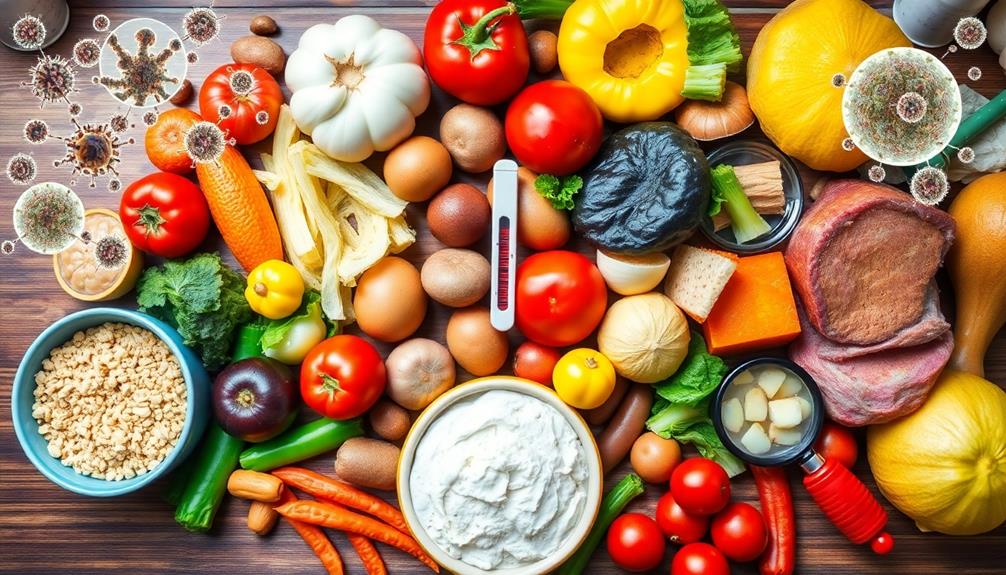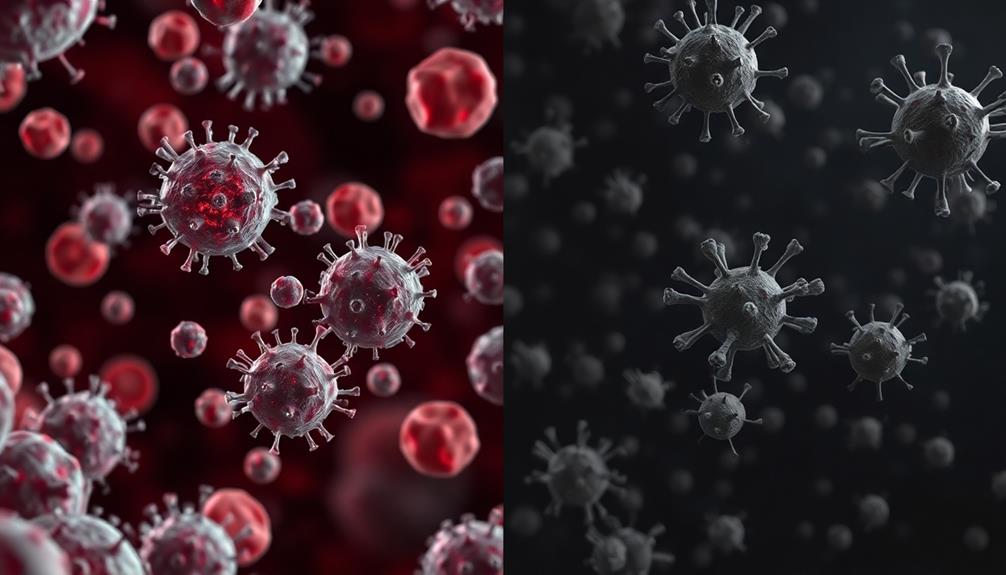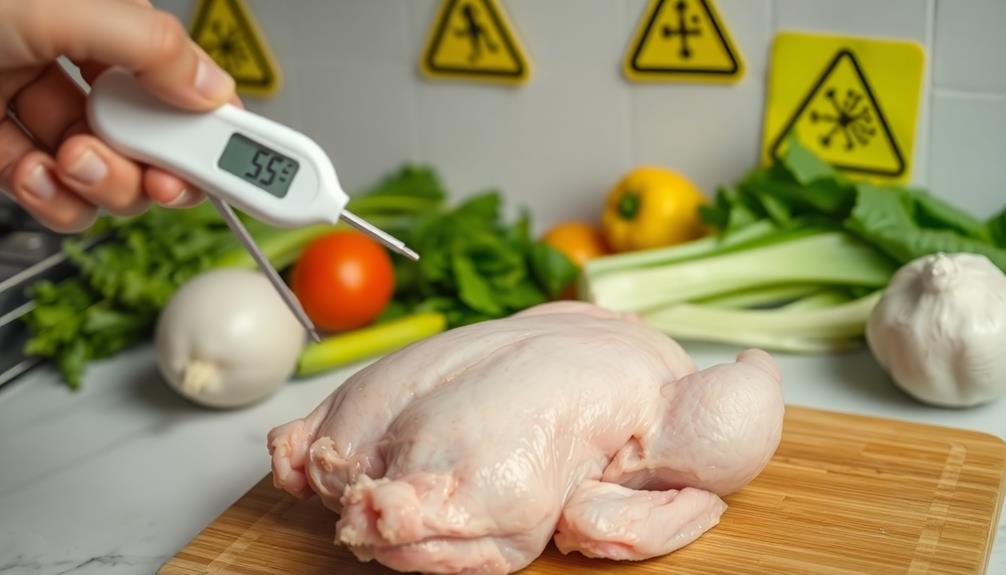You're more prone to food poisoning if you're in a high-risk group, such as the elderly, young children, or pregnant women. Your immune system plays a crucial role; if it's weakened from illness or age, you're at greater risk. Certain foods, like undercooked meats and raw eggs, often harbor harmful bacteria. Additionally, factors like recent surgery or chronic conditions increase susceptibility. Poor food handling and storage also contribute to contamination, making foodborne illnesses more likely for some. If you want to understand how to protect yourself and others, there's more important information ahead.
Key Takeaways
- Individuals aged 65 or older have nearly 50% higher hospitalization rates for foodborne illnesses due to weakened immune systems.
- Children under 5 are particularly vulnerable, being three times more likely to be hospitalized for Salmonella infections.
- Pregnant women face a tenfold increased risk of Listeria infection, which can severely affect both mother and baby.
- Those with weakened immune systems, such as individuals with chronic illnesses like cancer or diabetes, have a heightened susceptibility to food poisoning.
- Reduced stomach acid production increases the risk of harmful bacteria surviving and causing illness, making certain groups more prone to food poisoning.
Overview of Food Poisoning

Food poisoning can sneak up on you when you least expect it, resulting from consuming contaminated food. This contamination can stem from various sources, including bacteria, viruses, parasites, and fungi. Common culprits include high-risk foods like raw eggs, undercooked meats, and contaminated produce.
Certain dishes, such as Red-Braised Pork Belly, can be particularly risky if not prepared properly. The symptoms of foodborne illness often manifest within hours to days after consumption, leaving you with discomforting signs like diarrhea, nausea, vomiting, and stomach pain.
Understanding how food poisoning works is vital for prevention. When you ingest contaminated food, harmful microorganisms can multiply in your digestive system, leading to illness.
Certain populations, especially those with weakened immune systems, are more vulnerable to severe foodborne illnesses. This makes it essential for everyone to practice safe food handling procedures, such as cooking food thoroughly and keeping perishable items refrigerated.
High-Risk Groups

Certain groups of people face heightened risks when it comes to food poisoning. If you're 65 or older, you're nearly 50% more likely to be hospitalized for foodborne illnesses due to a weakened immune system.
Additionally, certain cultural dishes, like Muamba De Galinha, can pose risks if not prepared safely. For children under 5, the risk is even greater; they're three times more likely to be hospitalized for Salmonella infections, making food safety practices vital.
Individuals with weakened immune systems, such as those with diabetes or liver disease, face significant risks from pathogens like Listeria.
Pregnant women are particularly vulnerable, with a tenfold increased risk of Listeria infection, which can harm both mother and baby. Recent surgical patients and those with chronic illnesses like cancer or HIV also find themselves at higher risk due to compromised immune defenses.
Understanding these high-risk groups is essential for effective food safety measures. If you belong to one of these categories, it's important to be vigilant about the food you consume.
Immune System Impact

When your immune system is weakened, whether due to age, illness, or medication, you're more susceptible to foodborne illnesses. Individuals undergoing chemotherapy or living with conditions like diabetes or liver disease face a higher risk because their bodies struggle to fight off pathogens effectively.
As you age, your immune response diminishes, resulting in nearly 50% of older adults with lab-confirmed foodborne illnesses needing hospitalization. Additionally, certain foods, such as the traditional Ethiopian dish Yetimatim Fitfit, which can be enjoyed as a light meal, may pose risks if not prepared properly.
Children under five also have developing immune systems, making them three times more likely to be hospitalized for Salmonella infections compared to older populations. Strong stomach acid is vital for neutralizing harmful bacteria, so if you produce less stomach acid—common in the elderly or those taking antacids—you may find yourself at a higher risk for foodborne illness.
Additionally, a healthy gut microbiome, including lactic acid bacteria, plays a key role in preventing harmful bacteria growth. A decrease in these beneficial microbes can leave you more vulnerable to foodborne pathogens.
Common Contaminants

When you think about food poisoning, common contaminants like bacteria, viruses, and chemicals come to mind. Bacterial pathogens such as Salmonella and E. coli often lurk in undercooked meats and contaminated produce, while viruses like Norovirus can spread through improperly handled food.
Additionally, chemical contaminants from pesticides and heavy metals can pose serious health risks when they make their way into your meals.
It's also important to take into account that some traditional dishes, such as Caldeirada, may require specific cooking techniques to guarantee safety and prevent any risk of contamination.
Proper handling and cooking of ingredients, especially seafood, are essential to avoid foodborne illnesses.
Bacterial Pathogens Overview
Foodborne illnesses are often the result of contamination by common bacterial pathogens, including Salmonella, Escherichia coli (E. coli), Listeria, and Campylobacter. These bacterial pathogens can contaminate food at various production stages, leading to serious health risks.
For instance, the preparation of traditional dishes like bulgogi involves marinated beef that must be cooked properly to avoid contamination. Salmonella is frequently found in raw or undercooked eggs, poultry, and unpasteurized milk, making improper cooking a major concern. E. coli is often associated with undercooked ground beef and contaminated produce, which can cause severe gastrointestinal distress.
Listeria is particularly insidious, as it can grow even at refrigeration temperatures. This makes deli meats and soft cheeses especially dangerous, particularly for pregnant individuals and those with weakened immune systems.
Campylobacter, commonly found in raw or undercooked poultry, is one of the leading causes of bacterial food poisoning worldwide.
You need to be aware that food contaminated with these pathogens can result in hospitalization, especially among high-risk groups. Improper food handling and cooking practices often lead to infections, so it's essential to follow safe food preparation guidelines to minimize your risk of foodborne illness.
Understanding these common bacterial pathogens is the first step in safeguarding your health.
Viral Contaminants Impact
Viral contaminants can wreak havoc on your health, often leading to sudden bouts of illness. Two common culprits are Norovirus and Hepatitis A, which can easily contaminate food or water.
Norovirus is notorious for its contagious nature, causing around 19 to 21 million illnesses annually in the U.S. You might encounter it in crowded places like cruise ships and restaurants, where outbreaks frequently occur. Additionally, it's crucial to practice safe food handling, especially during festive gatherings where dishes like Graveyard Taco Dip might be served.
Hepatitis A poses its own risk, as it can be transmitted through contaminated food, especially when food handlers neglect hygiene practices. This virus can lead to severe liver infection and systemic illness.
When infected, you may experience symptoms of food poisoning, such as nausea, vomiting, and diarrhea, which can strike suddenly, typically within 12 to 48 hours after exposure.
While most viral food poisoning cases resolve on their own without medical intervention, the risk of dehydration is significant, especially for high-risk groups like young children and the elderly. Staying informed about these viral contaminants can help you take precautions and reduce your chances of falling ill.
Toxins and Chemicals
While many people focus on bacteria and viruses, toxins and chemicals can also pose significant risks in our food supply. Toxins, like those produced by Staphylococcus aureus, can contaminate food and lead to rapid onset symptoms such as nausea and vomiting, often within hours of consumption.
Additionally, certain mushrooms and plants may contain naturally occurring toxins that can cause severe gastrointestinal distress or even be fatal if ingested. For instance, the use of certain ingredients in traditional dishes, such as Kue Putu, must be carefully managed to avoid contamination.
Chemical contaminants, including pesticides and heavy metals, can accumulate in food sources, posing long-term health risks and increasing your susceptibility to foodborne illnesses. Fish, particularly, can harbor harmful toxins like ciguatoxin and scombrotoxin, leading to neurological symptoms and gastrointestinal upset after consuming contaminated seafood.
It's essential to understand that inadequate cooking or improper storage of foods can facilitate the growth of bacterial toxins. As a result, adhering to food safety practices isn't just a good habit; it's vital for minimizing these risks.
Symptoms and Diagnosis

When you experience food poisoning, you might notice symptoms like diarrhea, nausea, and stomach pain that can hit quickly or take time to show up.
Certain foods, especially those that are prepared in unsanitary conditions, can heighten the risk of foodborne illnesses. For instance, dishes like Mushroom Masala can be safe when cooked properly, but mishandling ingredients can lead to contamination.
Diagnosing it can be tricky since these symptoms often overlap with other illnesses, leading healthcare providers to request tests like stool samples.
If you face severe symptoms, such as a high fever or bloody diarrhea, it's vital to seek medical help right away.
Common Symptoms Experienced
Food poisoning can hit you with a range of unpleasant symptoms that vary in severity. You might feel sick from food poisoning just a few hours after eating contaminated food, or it could take several days for symptoms to appear. Common symptoms include diarrhea, nausea, vomiting, stomach pain, fever, headache, and weakness.
After a big meal like Thanksgiving, where leftovers are common, it's essential to handle food safely to avoid these risks. For instance, a delicious turkey sandwich made from leftover turkey can be a quick and easy meal, but if not stored properly, it could lead to foodborne illness. The intensity and duration of these symptoms depend on the specific bacteria, virus, or toxin that caused the illness.
If you experience persistent high fever (over 102°F), bloody diarrhea, or can't keep fluids down, you should seek immediate medical attention. These signs indicate a more serious condition that requires prompt care.
It's also worth noting that some individuals can carry bacteria without showing symptoms, which means they can unknowingly spread the illness to others.
Being aware of these symptoms can help you recognize when you might be facing food poisoning. If you suspect you've consumed contaminated food, monitoring your symptoms closely can guide your next steps in seeking care or managing your recovery. Taking action quickly can make a significant difference in your health outcomes.
Diagnostic Procedures Used
To diagnose food poisoning, healthcare providers start by evaluating your symptoms, such as diarrhea, nausea, vomiting, and abdominal pain, alongside any recent meals you've consumed. This initial assessment is vital to pinpoint the potential cause of your illness.
Depending on what you report, they may ask for stool samples to identify specific bacteria or parasites responsible for your symptoms. For instance, consuming dishes like Nettle and Potato Soup made from fresh, foraged ingredients can sometimes lead to unexpected reactions.
If your symptoms are severe or persistent, blood tests might also be conducted. These tests can reveal signs of infection or dehydration, which are important to address promptly.
Keep in mind that the onset of symptoms varies greatly based on the type of contagion. While some infections can show symptoms within hours, others may take days to manifest. This variation can complicate your diagnosis, making it essential to share every detail with your healthcare provider.
It's particularly important to report any unusual symptoms, like a high fever or bloody diarrhea, as these can indicate a more serious bacterial infection requiring urgent medical attention.
Overlapping Illness Challenges
Diagnosing food poisoning can be tricky due to the overlapping symptoms with various other illnesses. You might experience symptoms of food poisoning like diarrhea, nausea, and vomiting, which can easily be mistaken for other conditions. This overlap complicates your ability to pinpoint the exact cause of your discomfort.
Here are a few reasons why accurate diagnosis is challenging:
- Varying Onset: Symptoms can appear within hours or take several days, making it hard to identify the source.
- Non-Specific Symptoms: Many illnesses share similar symptoms, so distinguishing food poisoning can be difficult.
- Carrier Complications: Some individuals may carry pathogens without showing any symptoms, unknowingly spreading the illness.
- Concurrent Illnesses: If you have other health issues, they can mask or mimic food poisoning symptoms, leading to misdiagnosis.
When you're likely to get sick, the uncertainty can be frustrating.
Healthcare providers often need stool samples or blood tests to confirm specific bacteria or parasites, which adds to the time and stress involved in getting a proper diagnosis.
Awareness of these overlapping challenges can help you seek timely care when needed.
Prevention Strategies

Implementing effective prevention strategies is vital to reducing your risk of food poisoning. Start by practicing safe food handling techniques—frequently wash your hands and sanitize surfaces to minimize the spread of harmful bacteria.
When preparing meals, keep raw meat and poultry separate from ready-to-eat foods to prevent cross-contamination, which is a common cause of foodborne illness.
Cooking foods to their appropriate internal temperatures is fundamental. For instance, make certain poultry reaches at least 165°F (74°C) to kill any harmful pathogens.
Additionally, don't forget to refrigerate leftovers promptly, ideally within 2 hours of cooking, to inhibit bacterial growth.
If you have children under the age of 5, they're at a higher risk for food poisoning. Educating yourself and other caregivers about food safety measures is essential.
Avoid serving raw or undercooked foods, and make sure that meals are prepared with extra care. By taking these steps, you can greatly lower your chances of foodborne illnesses and keep your family safe.
Seeking Medical Help

If you experience symptoms like a persistent high fever, bloody diarrhea, or can't keep fluids down, it's crucial to seek medical help. These signs can indicate severe food poisoning, and waiting too long could worsen your condition. Don't hesitate; your health matters.
Here are some critical symptoms to watch out for:
- Persistent high fever (over 102°F) – This could signal a serious infection.
- Bloody diarrhea – This isn't normal and requires immediate attention.
- Dark urine or lack of urination – These signs indicate dehydration, which can be life-threatening.
- Symptoms that worsen or don't improve within 24-48 hours – If you're still feeling sick, get care right away.
It's especially important for pregnant individuals, breastfeeding mothers, or those caring for high-risk individuals to consult a healthcare provider at the first sign of food poisoning symptoms.
Your well-being affects not just you but those you care for, too. Reporting your case can also help public health departments monitor outbreaks, contributing to community safety.
Don't ignore your body; it's telling you to act.
Frequently Asked Questions
What People Are at High Risk of Food Poisoning?
You're at higher risk for food poisoning if you're over 65, under 5, pregnant, or have a weakened immune system. Recent surgery or long-term illnesses can also increase your vulnerability to foodborne pathogens.
What Increases the Risk of Food Poisoning?
Certain factors increase your risk of food poisoning. These include a weakened immune system, age, chronic health conditions, and pregnancy. Consuming contaminated food or insufficiently cooked meals can also heighten your chances of getting sick.
What Is the #1 Food That Causes Food Poisoning?
Did you know that poultry accounts for about 25% of foodborne illnesses in the U.S.? When considering the number one cause of food poisoning, undercooked or raw poultry tops the list, posing significant health risks for you.
What Is the Largest Contributor Towards Food Poisoning?
The largest contributor to food poisoning is consuming contaminated food. You can minimize your risk by ensuring proper cooking temperatures, practicing good hygiene, and avoiding high-risk foods like raw eggs, poultry, and unwashed fruits.
Conclusion
In a world where food can turn from delicious to dangerous in the blink of an eye, knowing your risk is vital. Your immune system is your shield, but even the strongest can falter against stealthy contaminants lurking in meals. By taking preventive steps, you can dodge the gut-wrenching misery of food poisoning. Don't let a careless bite ruin your day—stay informed, stay cautious, and savor every meal without fear! Your health deserves that kind of protection! Beyond just physical health, being mindful of what and how much we eat also plays a significant role. The psychological impact of clean plate syndrome—the pressure to finish everything on your plate regardless of hunger—can lead to overeating or ignoring signs of spoilage in the pursuit of not wasting food. Striking a balance between sustainability, mindful eating, and food safety is key to truly enjoying meals without compromising well-being.










